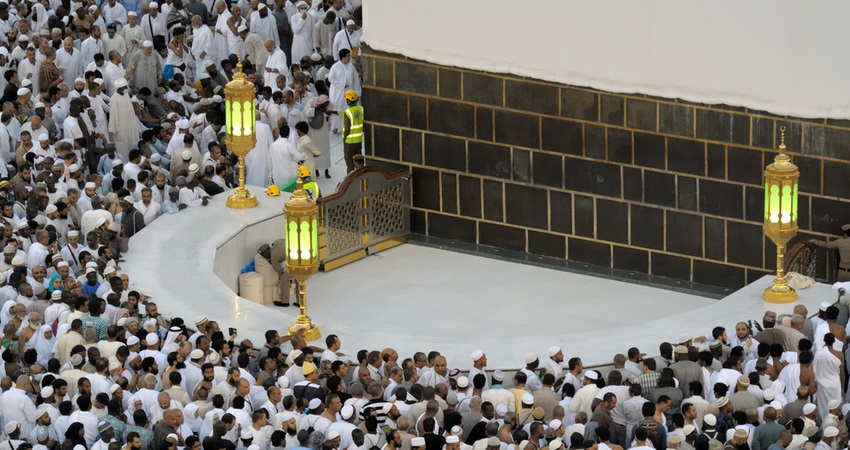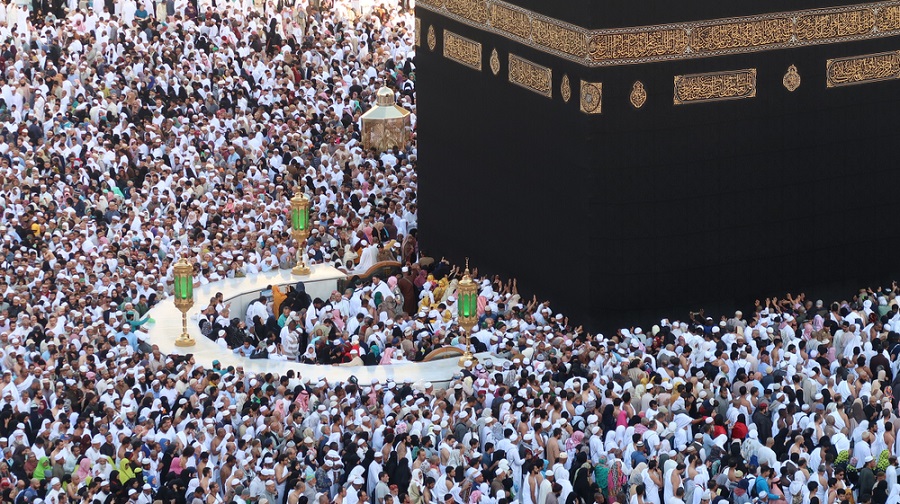Hijr Ismail is the name of a low wall, also known as Al Hateem, which is a part of the Kaaba in Makkah. It is a semi-circular wall made of white marble and is located in the North-West wall of the Kaaba. The wall is 4 feet and 4 inches in height. For a long time in history, the space engulfed by the Hijr Ismail was a part of Kaaba, and therefore, pilgrims do not enter it during Tawaf (encircling the Kaaba during Hajj or Umrah).
According to the legends, a part of Hijr Ismail was a place where Ibrahim created a shelter for His wife Hagar and son Ismail. Many people refer to it as ‘ruins’, but Muslims believed that Prophet Muhammad (PBUH) called it a ‘barrier’ or ‘wall’. Adjacent to the wall of the Kaaba, approximately 3 metres of Hijr Ismail, the area is a part of it while the rest lies outside of its boundaries. Hence, while performing Tawaf, Muslims stay entirely out of the semi-circular wall. The outlet of mercy, also called ‘Meezab-e-Rahmat’ pours down water after channelling through the roof of the Kaaba.
Significance of Hijr Ismail
Even before Islam, Hijr Ismail held importance in the eyes of the believers. It was a special place for the grandfather of the Holy Prophet, ‘Abd al-Muttalib’. It was His place, and no one else used it or sat in the area in His time. It was inside Hijr Ismail that He saw dreams regarding the birth of the Prophet and digging of the holy well of Zamzam.
According to popular beliefs, the Holy Prophet also sat in Hateem after He began His mission. He worshipped Allah there and recited the Quran while answering questions of people. Many narrations say that Hijr Ismail was the place from where the Prophet ascended from the Al-Masjid Al-Haram. Many Imams have also done the same. Therefore, this area outside the Kaaba is of great significance in Islam.
Praying in Hijr Ismail (Hateem)
Hazrat Ayesha R.A narrated that he wanted to enter the Kaaba to pray inside. However, the Messenger of Allah (PBUH) caught his hand, and while admitting him to the Hateem, said that he must pray inside the Hijr Ismail when intended to enter the holy Kaaba.
It is believed that the blessings that one receives after praying inside the Al Hateem are equivalent to the rewards received by a pilgrim who prays inside the Kaaba. It is crowded in times when Muslims offer two Rakah of Nafl and worship Allah. On the contrary, it remains empty when Imam leads the prayers in the Masjid al-Haram.
Hijr Ismail History
The Hijr Ismail history can be traced to many sources that state that when Prophet Ibrahim, his wife Hagar and their son Ismail arrived in Makkah, they were guided by angel Jibreel and settled in the current structure. They made a shade using the branches of a tree. Hence, some hadiths mention the Hateem as ‘Bayt Ismail’, which translates to the ‘House of Ismail’. Many hadiths and Islamic sources reveal that Hajar was buried here after her death. To prevent people from walking all over her grave, Ismail created a fence around. Later, he was also buried in the Hateem. Quite a few resources say that some of Ismail’s daughters and prophets have a grave in Hijr Ismail.
When Prophet Muhammad (PBUH) was 35 years old, a flood caused some devastating damages to the Kaaba. It was already damaged by standing in the previous times, and therefore, the Quraish came forward for its reconstruction. Towards the end, people faced a financial crunch in the building of the Kaaba. As a result, they constructed a small wall around the original foundation that was laid down by Prophet Ibrahim. On the North-West side, that wall is recognised as Hijr Ismail.
Facts about Hateem in Kaaba
A few interesting facts about the Hijr Ismail Kaaba reflect upon its importance in Islam. They illustrate the events that took place in the area and made it sacred.
In Sahih al-Bukhari, Hazrat Jabir bin narrated that it was Hateem where he stood in front of the people of Quraish when they did not believe his story of Night Journey. Standing in front of all those people, he began to describe Jerusalem after Allah blessed him and displayed the city in front of him.
In Sahih Muslim, A’isha, wife of Allah’s Apostle, narrated that she heard the Messenger of Allah (PBUH) saying that if her people had not converted to Islam then, he would have spent the treasure of the Kaaba according to the wish of Allah. The doors would have been constructed on the level of the ground, and Hijr Ismail would have lied inside its boundary.
The holy Quran does not mention Hateem, but the narration in Imam al-Sadiq mentions an ‘ayat bayyinat’, which refers to Hijr Ismail in Al-Masjid Al-Haram. It is a low divider that saw several sacred events on its surface. It encompasses several stories of cultural importance.
Hijr Ismail FAQs
Which is the best spot in Hateem to offer prayers?
If pilgrims follow the conducts of the Prophet and the Imams, the area or the spot below the outlet of mercy is the right place for making supplication and prayer.
What is the meaning of Hijr?
Hijr refers to prohibit, support and keep. It acts as a barrier between the holy Kaaba and the people who circulate it. Therefore, the area between the Kaaba and the semi-circular wall is referred to as Hijr Ismail.
Is Hijr Ismail always been made of marble?
No, the initial construction of the wall was done with desert stones. Over a period in history, many reconstructions included the use of white marble stones for building the semi-circular wall.
What is the width of Hijr Ismail?
The distance between the two entrances of Hateem is about 8 metres. Its middle point is 8.44 metres away from the northern wall of the Kaaba.
What are the contrary beliefs surrounding Hateem?
Many scholars believe that Hijr Ismail is not a part of the Kaaba. There are conclusions driven from a few narratives that contradict its sacredness. Hence, those people do not believe that pilgrims should pray here.










